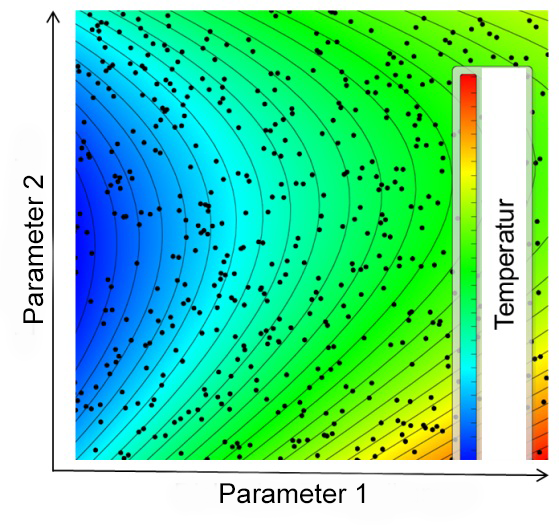High performance computing cluster allows extensive reliability-analysis

The demands on robustness and lifetime of electronic components, combined with decreasing development time, require methods that are able to derive the complexity of a system, evaluate it and indicate possible optimization potential in conceivable time. The use of numerical simulation methods offers the possibility to derive complex relationships between several design parameters (e.g. material properties or geometrical variations). Whereas, with numerical simulations multiple variations can be tested in a relative short time, in a real experiment each variation has to be represented by a prototype that has to be manufactured and tested for extensive time followed by an evaluation. From the results of such a systematic study, design rules or trend graphs (see image) can be extracted, which can provide useful information on possible optimization potential or for future development.
In order to realize these numerical investigations in a conceivable time, it is necessary to parallelize the computational effort. Fraunhofer IZM is equipped with a High Performance Computing cluster (HPC), where 16 powerful computers, each with 12 cores and 96 GB RAM, are connected with each other. This allows us to adapt the complexity of the simulation models to describe reality in more detail, to take multiple interactions into account and to record the variables influencing the reliability by means of significance analyzes and response surface analyzes to an unprecedented extent.
Possible application examples include optimization and sensitivity analysis for material and geometrical properties that aim for a long lifetime and optimized thermal management. The following list gives an impression for which problems the HPC is used
- Material properties selection for molding-materials in order to achieve high thermal cycling durability
- Identification of ReDistribution Layer (RDL)-materials with reduced warpage-properties
- Qualification of Thermal-Interface-Materials (TIM) for reduced thermal resistance and thermo-mechanical deformation
- Derivation of optimization strategies for layouts from a thermal, mechanical and electrical point of view
- Heatsink and housing geometry optimization for a better thermal management
- Heat-path optimization for embedded power electronics or 3D silicon interposers
- Optimization of chip interconnection technology for high-temperature electronics
In order to use this methodology effectively and successfully, of course profound know-how of the used technologies and materials is necessary, since the numerical models are only as good as the input parameters (material properties and failure hypotheses) implemented.
 Fraunhofer Institute for Reliability and Microintegration IZM
Fraunhofer Institute for Reliability and Microintegration IZM